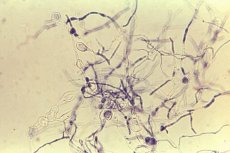Medical expert of the article
New publications
Trichophytosis pathogens (Trichophyton)
Last reviewed: 08.07.2025

All iLive content is medically reviewed or fact checked to ensure as much factual accuracy as possible.
We have strict sourcing guidelines and only link to reputable media sites, academic research institutions and, whenever possible, medically peer reviewed studies. Note that the numbers in parentheses ([1], [2], etc.) are clickable links to these studies.
If you feel that any of our content is inaccurate, out-of-date, or otherwise questionable, please select it and press Ctrl + Enter.

Trichophytosis (synonym: ringworm) is caused by fungi of the genus Trichophyton. A distinction is made between anthroponotic and zooanthroponotic trichophytosis.
Anthraponous (superficial) trichophytosis is caused by T. tonsurans and T. vialaceum. The incubation period is 1 week. Only people, more often children, get sick. Infection occurs through close contact with a sick person or through household items. Wrestlers have become frequently affected as a result of T. tonsurans transmission by contact (gladiator's corpus lichen). Inflammation and peeling of the center of oval skin lesions develop. Hair is affected by the "endotrix" type and breaks off at the skin surface. A pure culture of T. tonsurans is represented by thin (2-3 μm), colorless, rarely septate mycelium, pyriform microconidia, arthrospores, chlamydospores, and sometimes macroconidia. A pure culture of T. vialaceum consists of thin (3-4 μm), twisted, few-septate mycelium, various chlamydospores. In old cultures, arthrospores appear.
Zoonotic (infiltrative-suppurative) trichophytosis is caused by T. mentagrophytes var. mentagrophytes, which is transmitted to humans from mice and domestic animals. The scalp, beard, nails, and hair are affected. Abscesses and granulomas develop in the skin. Arthroconidia ("ectothrix") are present on the outside of the hair; hair falls out. A pure culture of the fungus consists of thin (2 μm) septate mycelium with isotopic hyphae, as well as rounded microconidia (2-4 μm), elongated macroconidia (8x40 μm), and chlamydospores.
T. verrucosum is transmitted to humans from cattle, calves, horses, donkeys, goats; it causes lesions of the skin, body hair, head and beard. Large lesions with scalloped outlines appear on exposed skin areas. It is located in the hair as an "ectothrix". A pure culture of the fungus consists of septate mycelium. Teardrop-shaped or elongated microconidia, spherical macroconidia (40x5 μm) in the form of a string of beads and numerous chlamydospores are formed.

